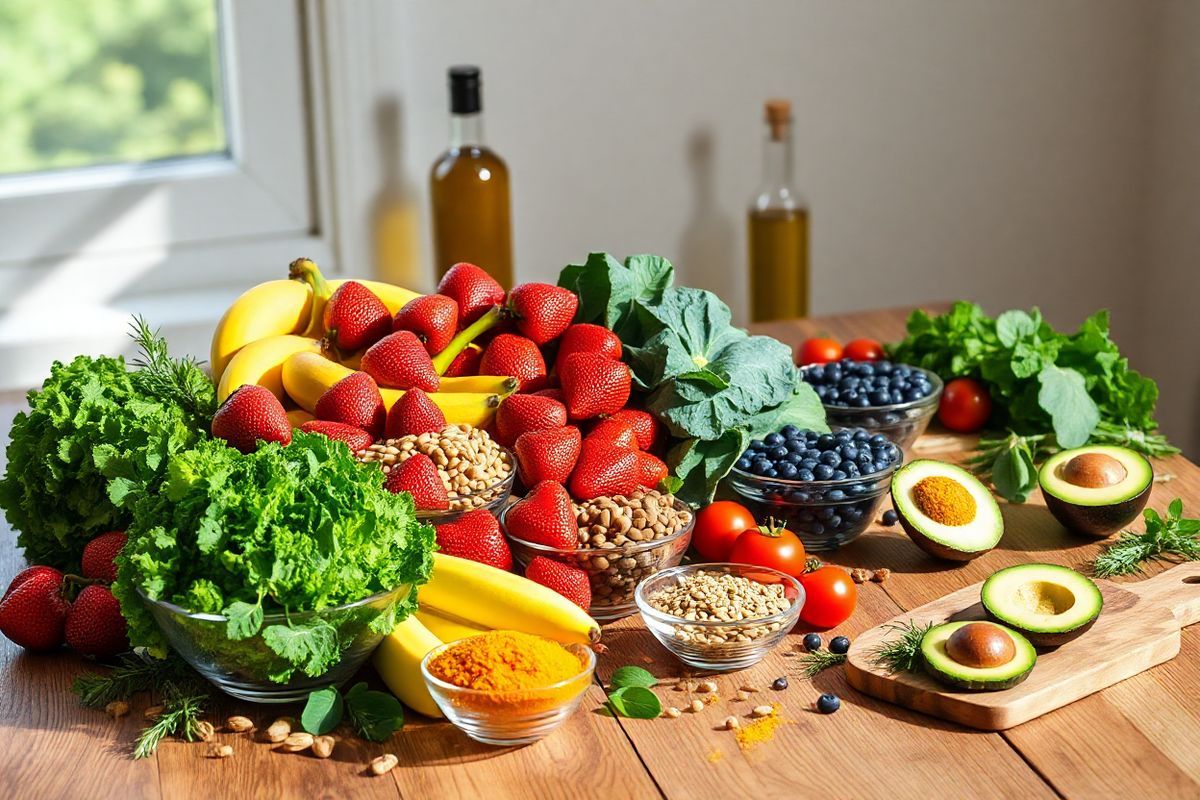Table of Contents
Understanding Inflammation: The Key to Healthier Eating

Inflammation is a complex biological response of the body to harmful stimuli, such as pathogens, damaged cells, or irritants. While inflammation is essential for healing and immune defense, chronic inflammation can lead to various health issues, including autoimmune diseases, cardiovascular diseases, and even certain cancers (Cleveland Clinic, n.d.).
There are two primary types of inflammation: acute and chronic. Acute inflammation occurs as a short-term response to injury or infection, often resulting in symptoms like swelling, redness, and pain. In contrast, chronic inflammation is a prolonged inflammatory response that can last for months or years. It often manifests without clear symptoms but can contribute to serious health conditions, including metabolic syndrome and neurodegenerative diseases (Cleveland Clinic, n.d.).
Understanding inflammation is crucial to making informed dietary choices. An anti-inflammatory diet is designed to reduce chronic inflammation in the body, which can help prevent the onset of disease and promote overall health.
The Power of an Anti-Inflammatory Diet: Why It Matters

An anti-inflammatory diet emphasizes foods that reduce inflammation and minimizes those that promote it. This diet is rooted in the principles of the Mediterranean and Asian dietary patterns, focusing on whole, minimally processed foods rich in nutrients and antioxidants (Food as Medicine: Anti-Inflammatory Diet, n.d.).
Key Benefits of an Anti-Inflammatory Diet:
-
Reduced Risk of Chronic Diseases: Many studies have shown that an anti-inflammatory diet can lower the risk of diseases such as obesity, heart disease, type 2 diabetes, and certain cancers (Food as Medicine: Anti-Inflammatory Diet, n.d.).
-
Improved Gut Health: Foods rich in fiber, such as whole grains, fruits, and vegetables, support gut health by promoting a diverse microbiome. A healthy gut contributes to reduced inflammation throughout the body (IBD-AID Diet, n.d.).
-
Enhanced Mental Health: Chronic inflammation has been linked to mental health disorders, including depression and anxiety. An anti-inflammatory diet may help support brain health and improve mood (Five Principles For An Anti-inflammatory Diet, n.d.).
-
Weight Management: By focusing on nutrient-dense foods, an anti-inflammatory diet can help with weight management, which is crucial for reducing inflammation levels and improving overall health (Adipose tissue fibrosis: the unwanted houseguest invited by obesity, n.d.).
Smart Food Swaps: Transform Your Meals for Reduced Inflammation
Transforming your meals into anti-inflammatory versions can be simple and delicious. Here are some effective food swaps to consider:
| Traditional Food | Anti-Inflammatory Swap |
|---|---|
| White bread | Whole grain or sprouted bread |
| White rice | Brown rice or quinoa |
| Sugary breakfast cereals | Oatmeal topped with fruits and nuts |
| Red meat | Fatty fish (salmon, mackerel) |
| Processed snacks | Fresh fruits, nuts, or hummus |
| Vegetable oils (canola, corn) | Extra virgin olive oil |
| Dairy products (whole milk) | Almond milk or coconut yogurt |
| Sugary desserts | Dark chocolate (70% cacao or higher) |
These swaps are not only beneficial for reducing inflammation but also contribute to improved overall health by providing essential nutrients and antioxidants.
Essential Ingredients to Include in Your Anti-Inflammatory Pantry
Stocking your pantry with the right ingredients can make it easier to follow an anti-inflammatory diet. Here are some staple items to consider:
- Fruits and Vegetables: Berries, leafy greens, tomatoes, and cruciferous vegetables (like broccoli and cauliflower) are all rich in antioxidants and vitamins.
- Healthy fats: Incorporate sources of omega-3 fatty acids such as fatty fish, chia seeds, flaxseeds, and walnuts. Use extra virgin olive oil as your primary cooking oil.
- Whole Grains: Choose whole grains like quinoa, brown rice, and oats, which provide fiber and essential nutrients.
- Legumes: Beans, lentils, and chickpeas are excellent sources of protein and fiber, making them great alternatives to meat.
- Herbs and Spices: Include anti-inflammatory spices like turmeric, ginger, garlic, and cinnamon in your cooking.
- Nuts and Seeds: Almonds, walnuts, chia seeds, and flaxseeds are nutrient-dense options that can enhance your meals.
Incorporating these ingredients into your meals will not only promote a healthy diet but will also aid in managing inflammation.
Creating Balanced Meals: Simple Tips for Sustaining an Anti-Inflammatory Lifestyle
To maintain an anti-inflammatory lifestyle, consider these tips for creating balanced meals:
-
Focus on Variety: Aim to include a variety of colors on your plate. Different colors often represent a range of nutrients and antioxidants critical for reducing inflammation.
-
Prioritize Whole Foods: Minimize processed foods and opt for whole, unprocessed options whenever possible. This helps reduce added sugars and unhealthy fats that can exacerbate inflammation.
-
Stay Hydrated: Drink plenty of water and consider herbal teas, which can offer additional health benefits. Limit sugary drinks and alcohol.
-
Mindful Eating: Take time to enjoy your meals and listen to your body’s hunger signals. Mindful eating can improve digestion and help prevent overeating.
-
Meal Prep: Prepare meals in advance to ensure you have healthy, anti-inflammatory options readily available during the week.
-
Experiment with Recipes: Explore new recipes that incorporate anti-inflammatory ingredients. Cooking can be a creative and enjoyable way to enhance your diet.
FAQs
What are the main foods to avoid on an anti-inflammatory diet?
Foods to avoid include refined carbohydrates, sugary beverages, red and processed meats, and trans fats. These foods can increase inflammation in the body.
Can I lose weight on an anti-inflammatory diet?
Yes, an anti-inflammatory diet can support weight loss by promoting whole, nutrient-dense foods that are lower in calories and higher in fiber, helping you feel full longer.
How long does it take to see the benefits of an anti-inflammatory diet?
Many people notice improvements in their health, such as reduced inflammation and better energy levels, within a few weeks of adopting an anti-inflammatory diet.
Is it necessary to eliminate all dairy products?
Not necessarily. Many find that fermented dairy products like yogurt and kefir can be beneficial for gut health. If dairy causes discomfort, consider plant-based alternatives.
Can I include snacks in an anti-inflammatory diet?
Absolutely! Healthy snacks like fruits, nuts, seeds, and vegetables with hummus can be excellent choices that align with an anti-inflammatory diet.
References
- Cleveland Clinic. (n.d.). What Is Inflammation? Types, Causes & Treatment. Retrieved from https://my.clevelandclinic.org/health/symptoms/21660-inflammation
- Food as Medicine: Anti-Inflammatory diet. (n.d.). Retrieved from https://www.chop.edu/health-resources/food-medicine-anti-inflammatory-diet
- IBD-AID Diet. (n.d.). Retrieved from https://www.umassmed.edu/nutrition/ibd/ibdaid/
- Adipose tissue fibrosis: the unwanted houseguest invited by obesity. (n.d.). Retrieved from https://pubmed.ncbi.nlm.nih.gov/11648981/
- Five Principles For An Anti-inflammatory Diet. (n.d.). Retrieved from https://www.piedmont.org/living-real-change/the-anti-inflammatory-diet











